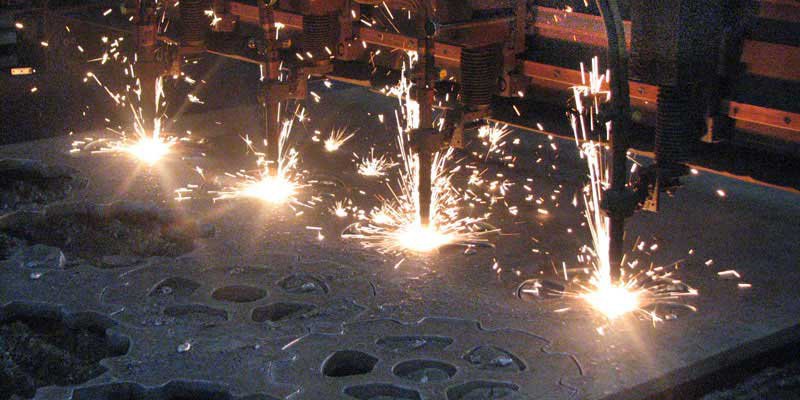Like plasma cutting, oxy-cutting is one of the first cutting technologies that Alma software was used for in the early 1980s. Alma has therefore a strong presence in industries that use thick sheet metal and with sub-contractors. Alma innovated very early on to optimize programming methods specific to oxy-cutting: multi-torch programming with smart nesting, bevel programming reduction of drilling on sheet metal, support of thermal requirements during cutting, etc.
The oxy-cutting technological process
Oxy-cutting is a cutting process that oxidizes the metal by projecting a jet of pure oxygen combined with a pre-heat flame (oxy-gas) for which gases like acetylene or tetrene are used. The oxygen jet is projected onto an area of the part that has been pre-heated to fusion temperature close to 1,300°. Cutting is performed via rapid oxidization by the oxygen jet, and not by the force of the jet. Combustion occurs in the cut area and throughout the whole thickness of the cut part. The oxides that form are mechanically eliminated by the cutting jet. The cutting quality depends on the purity of the oxygen.
Oxy-cutting is suitable for cutting thick and very thick sheets of unalloyed and low-alloyed steel (> 20 mm). Main advantages of this process: low cost of equipment and functioning, capacity to cut very thick parts, increase in productivity in multi-torch configuration, etc.
Oxy-cutting is used in particular in ship-building, boiler-making and steel frames.

Almacam Cut advantages for oxy-cutting
The performance of Almacam Cut in oxy-cutting is due in particular to the complete support of thermal constraints and machine specificities, as well as an effective combination of automation and the possibility for the user to intervene in specific situations.
Significant material savings
- Significant reduction of loss rates thanks to automatic nesting performance, since there is a choice of several available strategies.
- Multi-torch nesting available either in automatic or interactive mode, with the calculation of the smallest gap between the torches, lower than the height of parts that can be embedded with themselves; possibility to combine multi- and mono-torch cutting in a single nesting.
- Generation and re-use of off-cuts of any shape, e.g. resulting from inner profiles.
Minimized programming times
- Management of repetitive nesting and sub-nesting (kits) enabling future re-use of optimized programs.
- Possibility to modify the profile characteristics (lead-ins/outs, bevels, etc.); which avoids modifying the geometry.
Savings on consumables
- Limited quantity of sheet drilling thanks to several cutting methods: chain cutting and common cut between two parts, lead-in in the lead-out from the previous part.
- Use of the pre-lead-in method (can be performed with a used nozzle) when cutting thick sheet (pre-cutting of a rectangle to facilitate the lead-in).
Optimized time cycles
- Optimized computation of the tool paths.
- Multi-torch cutting minimizing the cut length (the automatic nesting computes the best compromise between the loss rate and the cycle time).
- Possibility to simultaneously cut several sheets in multi-torch configurations.
- Reduced cycle times thanks to different methods to avoid drilling by profile: chain cutting and common cut, lead-in in the lead-out of the previous part.
Complete mastering of the technological process and complex machines
- Operation of programmable torch machines, with automatic clamping or gap between torches.
- Ability to control programmable beveling heads while automatically preparing the program: automatic generation of the reconfiguration loops or lead-ins/outs, generation of an overall profile to take into account the maximum bulk of the part in the nesting, allocation of cutting conditions according to the angle.
- Support of any process related to oxy-cutting: drilling and marking systems (zinc powder, needle stylus, etc.)
An approach that contributes to improving the quality of manufactured parts
- Heat deformation taken into account thanks to several automatic or semi-automatic functions: parts cut out in several passes (split), heat distribution over the sheet with specific cutting sequence, etc.
- Automatic position of lead-ins/outs to terminate cutting of parts in the middle of the material (far from sheet edge).
- Automatic lead-ins/outs (position, type, length and angle) according to the material and thickness.
- Detection and automatic correction of false lead-ins/outs.
- Specific lead-ins/outs (in dovetail) in sheet edge to avoid spreading of material strips.
- Choice of order of torches to use for better distribution of diffused heat in the material.
Methods to facilitate handling in the workshop
Hierarchical nesting using priority groups to easily sort the parts during evacuation.